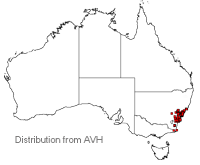Allocasuarina distyla
Shrubby She-oak
Allocasuarina distyla (Vent.) L.Johnson
Allocasuarina distyla (the Shrubby She-oak) usually grows to 2-3 meters in height, although in richer soils it can reach 7 metres tall. Typical of the Casuarinaceae family the foliage is made up of branchlets with ‘articles’ joined one on top of the other, and ‘teeth’ surrounding the distal end of each article. Branchlets grow to 35 cm long; articles are smooth, 10-20 mm long, 0.8-1.5 diameter, occasionally waxy, pubescent (or hairy) in the furrows. Plants have smooth bark and are dioecious, meaning that male and female flowers occur on separate trees. Flowering occurs mostly between July and September, although can be variable depending on rainfall events. Female flowers are red in colour and produce long-cylindrical cones often with a sterile apex up to 12 mm long. Male flowers form in spikes between 1.5 and 9 cm long and have 4.5-6.5 whorls per cm; each anther is 0.8-1.3 mm long.
 Allocasuarina distyla naturally occurs in tall heath and on sandstone ridge-tops in NSW from the south side of Port Stephens and Gospers Mountain, south to the ranges east of Cooma. There have also been collections made on the upper Genoa River in northeast Victoria.
Allocasuarina distyla naturally occurs in tall heath and on sandstone ridge-tops in NSW from the south side of Port Stephens and Gospers Mountain, south to the ranges east of Cooma. There have also been collections made on the upper Genoa River in northeast Victoria.
To cultivate Allocasuarina distyla, collect mature unopened cones and place them in a paper bag for 3 to 4 days in hot dry weather, or longer in cool weather. Seeds drop into the bag and can be planted immediately or at any time of the year. Seeds should be planted with good soil at first, once established they can be planted into any soil type. Sandy soil is the least preferable as it increases susceptibility to insect attack. Adult plants need no extra watering but seedlings require water until they are a few feet tall. Fertilizer may be used but is not necessary because like wattles and members of the pea-family, Allocasuarina ‘fix’ atmospheric nitrogen through nodules on their roots, enriching impoverished soils.
Pruning plants can increase their strength. They can also sprout from basal epicormic buds, especially if conditions have been harsh and upper foliage has died. They are frost hardy, drought and salt tolerant, and are effected by very few parasites, the most notable being the scale insect.
Plants in the genus Allocasuarina are often planted to attract birds such as finches, lorikeets and cockatoos that build nests in the branches or feed on the flowers and seeds.
Allocasuarina distyla are desirable ornamental shrubs with interesting fruit seed pods and stunning flowers and foliage. More subtly, and of no less value, is the pleasant sound of wind breezing through the branchlets. They have an excellent value for use as screens or wind-breaks, and for this reason are planted as street trees in NSW. They are also beneficial in soil stabilisation and erosion control.
Allocasuarina distyla is a lovely, yet hardy shrub, very easy to propagate and care for and ideal for growing in poor soil and no-water gardens as it has excellent tolerance to drought and saline conditions. They are considered vulnerable (at risk of disappearing from the wild in 20-50 years) but are becoming more common as garden plants with commercial propagation already occurring at several nurseries in NSW and Victoria.
Text by Rainbo Dixon (2007 Botanical Intern)
Name Meaning: Allocasuarina distylaAllocasuarina – ‘allos’ meaning ‘other’ (Greek) and ‘Casuarina’, the closely related genus from which Allocasuarina were split in 1982 which was named after the cassowary, Casuarius casuarius, in allusion to the supposed resemblance of the ‘foliage’ to the cassowary’s plume. distyla – ‘di’ meaning ‘two’ (Greek) and ‘stylos’ meaning ‘column’ (Latin) refering to the style of the flower. Thus ‘distya’ refers to the bifid or split styles in the female flowers, a feature common to all species of Casuarinaceae. |
References
Baines, J.A. 1981. Australian Plant Genera: An Etymological Dictionary of Australian Plant Genera, Society for Growing Australian Plants
Wrigley, J.W. & Fagg, M. 1996. Australian Native Plants; Propagation, Cultivation and Use in Landscaping. Fourth Edition, Reed New Holland
Australian Museum . 2005. Birds in Backyards. Available at http://birdsinbackyards.net/spaces/display.cfm?id=15 [accessed February 2007]
Indigenous Landscape Design Australia. 1998. ‘ Slender, Graceful She-oaks’. Available at http://www.ilda.com.au/page/archives.html [accessed February 2007]
Wilson , K.L. & Johnson, L.A.S. 1989. Casuarinaceae in George, A.S. (ed.) Flora of Australia. Volume 3. Hamamelidales to Casuarinales, Australian Government Publishing service, Canberra
![An Australian Government Initiative [logo]](/images/austgovt_brown_90px.gif)




